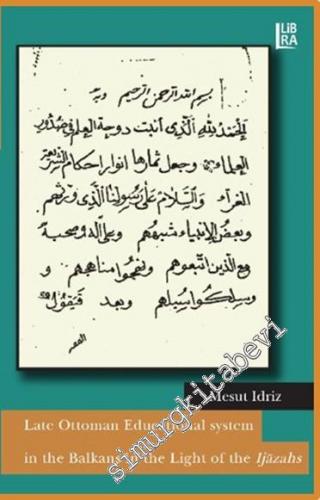#smrgKİTABEVİ Late Ottoman Educational System in the Balkans in the Light of the Ijazahs -

During the 3rd century of Hijrah/9th century of C.E., this tradition had a strong impact to the higher learning institutions of Europe, where it is believed that granting diploma/license was the product of the Muslim tradition ofijazah, but in terms of the form and content the former differed completely from the latter. Besides the central regions of the Muslim world, the ijazah system appeared and practised extensively in the periphery, where this can be clearly seen in the regions of Southeast Asia and Southeast Europe.
Though modern-day diploma replaced ijazah, this practice is still alive in certain parts of these regions; however, it is not recognised “officially” by the government higher learning institutions. Up to this moment, this research managed to interview and discuss with number of ‘ulama who have been granted ijazah from their preceding scholars from various countries of the Balkans.
ABBREVIATIONS
FOREWORD
CHAPTER ONE: INTRODUCTORY REMARKS ON THE HISTORY OF ISLAMIC EDUCATION
CHAPTER TWO: IJ?ZAH AS A UNIQUE TRADITION IN THE HISTORY OF EDUCATION
The Meaning of Ij?zah
The Tradition of Ij?zah in the Muslim World and Its Significance
The Examinations
The Age of Students for Granting Ij?zah
The Ij?zah: Personal Act of Authorization
Types of Ij?zah
The significance of Ij?zah
The Genres of Ij?zah
The Structure and Content of the Ij?zahs
Main Differences Between Ij?zah and Certificate/Diploma
CHAPTER THREE: OTTOMAN EDUCATION IN THE BALKANS WITH REFERENCE TO IJ?ZAH
Language
Arrangement, Structure and Content
The introductory part
The main text
The colophon
CHAPTER FOUR: THE OTTOMAN BALKAN EDUCATION VIS-Á-VIS THE MAJOR PARTS OF THE MUSLIM WORLD: A BRIEF COMPARISON BASED ON IJ?ZAH TRADITION
Arabian Case
Persian Case
Anatolian Cases
CHAPTER FIVE: INSTEAD OF CONCLUSION
APPENDİX
In the Name of Allah, the Beneficent, the Merciful
BIBLIOGRAPHY
INDEX
During the 3rd century of Hijrah/9th century of C.E., this tradition had a strong impact to the higher learning institutions of Europe, where it is believed that granting diploma/license was the product of the Muslim tradition ofijazah, but in terms of the form and content the former differed completely from the latter. Besides the central regions of the Muslim world, the ijazah system appeared and practised extensively in the periphery, where this can be clearly seen in the regions of Southeast Asia and Southeast Europe.
Though modern-day diploma replaced ijazah, this practice is still alive in certain parts of these regions; however, it is not recognised “officially” by the government higher learning institutions. Up to this moment, this research managed to interview and discuss with number of ‘ulama who have been granted ijazah from their preceding scholars from various countries of the Balkans.
ABBREVIATIONS
FOREWORD
CHAPTER ONE: INTRODUCTORY REMARKS ON THE HISTORY OF ISLAMIC EDUCATION
CHAPTER TWO: IJ?ZAH AS A UNIQUE TRADITION IN THE HISTORY OF EDUCATION
The Meaning of Ij?zah
The Tradition of Ij?zah in the Muslim World and Its Significance
The Examinations
The Age of Students for Granting Ij?zah
The Ij?zah: Personal Act of Authorization
Types of Ij?zah
The significance of Ij?zah
The Genres of Ij?zah
The Structure and Content of the Ij?zahs
Main Differences Between Ij?zah and Certificate/Diploma
CHAPTER THREE: OTTOMAN EDUCATION IN THE BALKANS WITH REFERENCE TO IJ?ZAH
Language
Arrangement, Structure and Content
The introductory part
The main text
The colophon
CHAPTER FOUR: THE OTTOMAN BALKAN EDUCATION VIS-Á-VIS THE MAJOR PARTS OF THE MUSLIM WORLD: A BRIEF COMPARISON BASED ON IJ?ZAH TRADITION
Arabian Case
Persian Case
Anatolian Cases
CHAPTER FIVE: INSTEAD OF CONCLUSION
APPENDİX
In the Name of Allah, the Beneficent, the Merciful
BIBLIOGRAPHY
INDEX





















